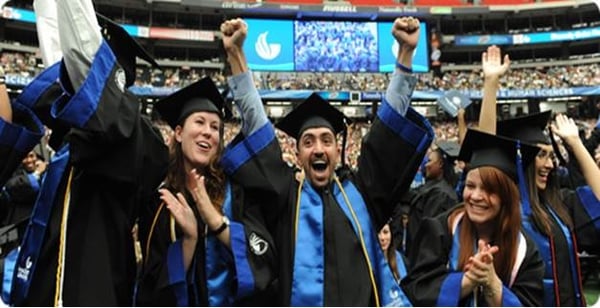Published on
Predictive Analytics Support Success Among At-Risk Student Populations (Part 2)

This is the conclusion of a two-part series by Timothy Renick discussing Georgia State University’s Graduate and Progression Success (GPS) program and its impact on at-risk, non-traditional students. In the first installment, Renick provided background on the program and the necessity of predictive analytics for student success. In this article, he goes into more detail about the effects the GPS program has had on at-risk students’ retention rates and financial stability, and shares his thoughts on some of the other strategies institutions can put into place to drive completion among this student population.
3. When it comes to at-risk student populations, how has the GPS program supported their success?
Some of the early indicators are that the impacts are going to be extremely positive. Since we went live with this tracking system, the retention rate for our incoming freshmen between the fall and spring semester has gone up by five full points. Students are, from the beginning, being better supported; they’re getting the help they need so they can succeed in the courses they take. We’ve also found that throughout the freshman year, these students are [earning] a higher percentage of the credits they attempt.
At the other end of the spectrum, we’ve seen something very encouraging as well. Even though our seniors have only been impacted by the system for two of their years, the average credit hours it took a graduate senior to accumulate in order to walk at graduation this spring was more than three credit hours less than the previous year. This means they’re accomplishing their college degree more efficiently, that they’re not taking excess credits. That’s more than $4 million in savings in tuition and fees for the graduating class of 2014.
Technology is helping us to really target these conversations on things that impact the student directly and can improve their chances of success directly. The students are very appreciative of having this new sort of information available, personalized and customized to their own abilities and needs.
4. What are a few other strategies you have found to be successful in supporting retention and success among at-risk students?
We can build on the same theme of trying to be as efficient as possible. On average, the American college student is taking about five courses they really don’t need to take and paying for them. That’s great if you have the resources and the personal funding, but for students who are predominantly low-income, first-generation college students who have very limited support, they’re much better served by getting through the program and the curriculum more efficiently.
We’re trying to accomplish that goal in a number of different ways.
We have tried to leverage one of the strengths we have at Georgia State, which is large numbers of low-income students who are on a work-study program. Previously, we had a lot of those students working in the cafeteria, answering phones in the front office. Now what we’ve done is we’ve looked at some of the freshman and sophomore year courses with the highest “DFW” (drop/fail/withdrawal) rates — the percent of students who are taking the course, paying for it but not getting a passing grade that advances them.We’re correlating the highest percent of courses with DFWs with work-study students who have done well in those very same courses.
Rather than assigning those students to the cafeteria or the library, we pay them to go through training, to sit in on the same class they succeeded in previously so they get to know the new students and the new instructor and we pay them to conduct tutoring and instructional sessions for the current students enrolled in the course over the semester. We found that the average letter grade for the students who avail themselves for this program is about half a letter grade higher. An added bonus is the graduation rate for the students who are the tutors has also gone up dramatically as well.
We’re now using adaptive learning systems in a number of hybrid classes. This past academic year, every single section we offered of introductory math was offered in a hybrid fashion. Rather than having students sit in a lecture hall three hours a week listening to a math professor lecture them about these topics, the students go to a lecture hall one hour a week and then spend three hours a week in a dedicated math lab, a computer lab, as a group. The instructors are present in the lab but each student is sitting in an individual terminal working on adaptive learning programs. The benefit of adaptive learning exercises, which customize the material to each individual student, is that if the student is struggling with a particular concept, that student will get more questions until they begin to master it.
For all those introductory math courses five years ago, about 40 percent of our students were getting Ds, Fs or withdrawing from the course. In just five years with that new system in place, we’ve cut that number in half. More than 1,600 more students every year are getting a passing grade in their required math course the first time they try it than was the case five years ago. It’s technology and it’s the abilities of technology to shape material to individual students that’s helped us in that program.
5. Is there anything you’d like to add about improvingefficiency of institutional operations as a mechanism to actually support student success?
At Georgia State, we’ve probably gotten more national attention than many other institutions because we’ve been willing to not only experiment with some of these programs, but scale them large. We’re using predictive analytics daily to track tens of thousands of students.
The lesson that has come from scaling programs of this sort at the large scale is that there really is a return on investment. Clearly, the main reason we’re doing these improvements and trying to help the students is because we have a moral imperative to do our best to equip students with the tools they need to succeed in life, and that includes getting a college degree and succeeding in mastering the courses they take.
An important business benefit is that many of these programs end up more than paying for themselves. Georgia State enrolls 32,000 students. Every time we retain one percent more students, that’s another 320 students that are enrolled. Every time we saved 320 students, we’re talking about between $2 and $3 million of added tuition and fee revenues to the university.
Last academic year, Georgia State graduated 1,700 more students than we were graduating just five years ago, and that’s almost entirely due to the greater success of the system and the people running them and supporting them. It’s not from enrolling more students at the front end. These types of interventions make a transformative difference in the prospects of students. When you’re talking about the type of students Georgia State enrolls — low income, underrepresented first-generation college students — these are mostly students who only have one shot at college. They don’t have a safety net; if they screw up, there’s not an uncle or a parent who’s going to be able to step in and write a check or get them out of trouble. They have the one chance to get through.
This interview has been edited for length.
The EvoLLLution and Destiny Solutions created an Executive Guide sharing six steps administrators need to take to better-serve non-traditional students. To download the Executive Guide, please click here.
Author Perspective: Administrator



